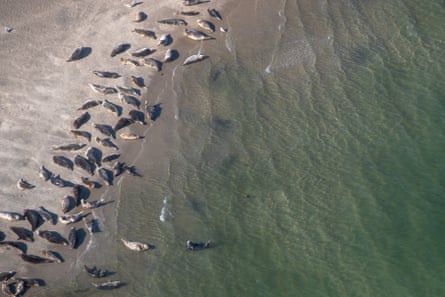Seals practise social distancing, aerial survey of North Sea shows | Marine life
Aerial surveys of the North Sea have revealed that seals practise social distancing – and the discovery may have profound implications for the spread of disease among the marine mammals.
In a paper published today by the Royal Society, researchers conducting censuses of grey and harbour seals detail new evidence that the two species not only maintain distances between their own kind (unlike walruses, for instance, who cluster close together) but also that this behaviour may “reflect an evolutionary response to viral susceptibility”.
“By comparing harbour seal colonies with grey seal colonies, we have found that harbour seals keep a greater distance from their neighbours than grey seals do,” the report’s lead author, Jeroen Hoekendijk, told the Guardian. With catastrophic rates of bird flu currently contributing to serious concerns about disease in wildlife, the new report may have important implications for the way such outbreaks are tracked.
The area surveyed was a wild expanse on the coast of the Dutch Wadden Sea, where both species of seals “haul out” on the intertidal flats and beaches to rest, socialise, mate and give birth. They gather there in great numbers. Up to 6,500 grey seals choose the high sandbanks, while harbour seals – about 8,000 were observed – prefer sands revealed at low tide.
Unfortunately, the large numbers of harbour seals have faced disastrous outbreaks of disease in the past. Phocine (seal) distemper virus ravaged the populations in 1988 and 2002, halving numbers. About 18,000 harbour seals died of distemper in the UK and Europe in the 1988 outbreak. Grey seals, however, remained relatively unharmed.

“Many grey seals were actually also infected, but just didn’t get as sick as harbour seals,” said Hoekendijk. “This may actually have contributed to the spread of the virus. They carry the virus, but can still move around freely.” He pointed to recent evidence that the grey’s reduced susceptibility had “genetic underpinnings”.
Fascinatingly, it may be that the social distancing described in the new report represents a memory of those severe outbreaks. “Other studies have shown that grey seals are more resistant to respiratory viruses than harbour seals,” said Hoekendijk. “The greater inter-animal distances that we’ve observed for harbour seals in our study might be a response … very similar to our response during the Covid pandemic.”
Comparisons with Covid are telling. Covid is itself a zoonotic disease – that is, transmissible from animals to humans. A report earlier this year showed that Covid was far more widespread in wild animals than hitherto thought. The disease is also thought to have affected marine mammals, and there are concerns the presence of human sewage released into the sea may spread Covid among seals and whales.
after newsletter promotion
Ironically, lockdown had benefits for the natural world. Reduced disturbance of wild areas – seals are particularly prone to interruption by human presence – and seas rendered quieter by the lack of vessels created a brief window of respite for many marine mammals. The lockdowns even halted seal culls in Namibia.
It is not a bad idea for humans to keep their distance from seals, too. Not only is there a danger of being bitten, the bites have been linked to potential human-animal zoonosis in the form of the notorious “seal finger” caused by contact with seals’ claws or teeth, which can transmit the bacterium Mycoplasma phocacerebrale. If the skin is broken, infection has led to the amputation of human digits among fishers and scientists.

